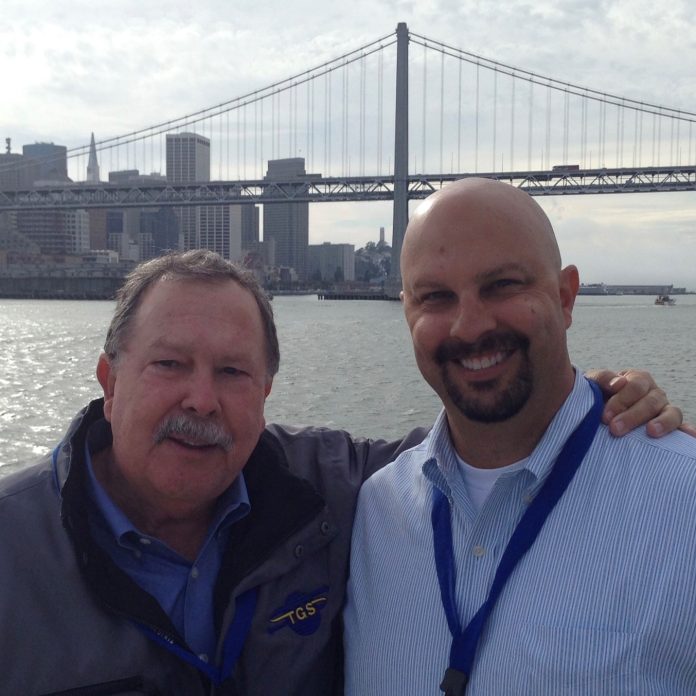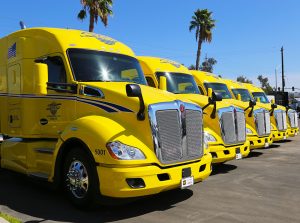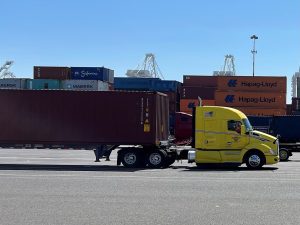
As president of TGS Transportation, it’s hard for Peter Schneider not to be aligned with California’s tree nut industry.
His Fresno-based drayage company transports more than 500 million pounds of almonds, pistachios and walnuts each year to the ports of Oakland, Los Angeles and Long Beach. TGS has been doing that since 1987, two years after Schneider’s father, Timothy, started the business. The company also hauls large amounts of powdered milk, raisins, seed and other agricultural products. In all, TGS runs as many as 150 trucks a day to the ports.
Today, Schneider, who’s also president of TGS Logistics, wrestles with many of the same challenges as tree nut growers, processors and shippers, from soaring fuel and labor costs, to increasing regulations, to perhaps the biggest issue of all: port and supply chain problems.
Those have led Schneider to serve on several industry committees and boards. He is on the supply-chain innovation team with the Federal Maritime Commission; executive vice president of the Harbor Trucking Association; chairman of the California Trucking Association’s Northern California Intermodal committee; on the Intermodal Interchange Executive Committee of the Intermodal Association of North America; a board advisor with the Ag Transportation Coalition; and a member of the Port Efficiency Task Force with the Port of Oakland.
These roles not only give him an eye into the vast workings of international shipping, so important to the West Coast tree nut industry, but a voice to call out both problems and solutions.
Schneider spoke with West Coast Nut in late June about his struggles and his message to tree nut producers and handlers.

Q. How have your costs risen in the last year or two?
In the last 19 months, the price of diesel has gone up about 120%, from $3.20 a gallon to $6.80 a gallon for diesel. That’s just a massive number. Our largest cost is usually labor cost. But right now, fuel has actually jumped over labor costs. Our labor costs have gone up about 30% to 35% for our company drivers and 35% to 40% for our independent contractors.
Q. What other challenges do you face as a company and as an industry?
How many hours do you have? From a trucking point of view, in California we’ve been regulated so much over the last 15 years. We’re getting ready for another bout of regulation through the California Air Resources Board. Effective January 1, all trucks must be 2010 and newer. So, 20% to 25% of trucks will be going away at the end of this year.
Q: How much of your fleet will you have to retire?
We have newer trucks, so I’m only going to lose between 5% to 15% of my fleet. Some trucking companies are getting newer trucks. But part of the problem with COVID-19 is the production and manufacturing of trucks is almost non-existent. The wait to get a new truck is a year to 18 months. For the industry to meet its needs, you have to buy a used truck, and a used truck that’s two or three years old is more expensive than a new one because of supply and demand.

Q. What else is really challenging you?
In the international shipping industry, we face a lot of challenges to do our job every day. You have the trucker, the steamship line, the marine terminal operators, the ports themselves, rail, brokers and the shippers, like the almond and pistachio shippers. Then there are other ancillary people in the supply chain. But everything is discombobulated. Everything is not in sync.
Q. What’s your view of the Ocean Shipping Reform Act, signed by President Biden June 16?
It’s phenomenal. Politically speaking, it isn’t clear and concise. But it does help identify an accountability for each of the supply chain people, including the steamship lines and the marine terminal operators. We’ve been hit hard with so many added costs, specifically for the exporters in our industry. They’ve paid 30% to 50% more than they did a year and a half ago. And that doesn’t include the labor cost I’ve had to pass on. Things were a lot worse a year ago. They’ve calmed down because we’ve all worked together in the supply chain to become more cohesive. But there’s still a lot of work to be done.
Q. Heading into the harvest season, what challenges do you expect in hauling almonds, pistachios and walnuts?
The Port of Oakland is the biggest gateway for all the exporters in the nut world. But it’s taken steps back, meaning it doesn’t have the services it once did with the steamship lines. Part of it is due to COVID-19 and a realignment of where they want their ships to go to or from, mainly in the trans-Pacific trade. Asia and China to L.A. and Long Beach is a massive trade lane. The only one bigger is China to the EU. Forty percent of all the imports to the U.S. go through L.A./Long Beach terminals. They take those empty containers back to China to go get more export Chinese products. So, they bypass Oakland a lot. Because there’s so much change since COVID-19 in the international trade, they’ve had to realign their ships to enhance where they make the most money. Ag exports are not a high profitability lane for them.
Now they see the downturn with the economy coming, and they’ve been getting a lot of flak nationally, internationally and regionally, especially from the Almond Alliance and several others in the ag advocacy world, so they are putting services in but not necessarily in Oakland.
A lot of the ag shippers are going now to Houston. Hapag-Lloyd, one of the top four or five steamship lines, does not call at Oakland anymore. Instead, you have to put it on the rail directly from Oakland to the Port of Norfolk, Va., and from there it goes to the EU, which is crazy. There’s just been a lot of change. The Port of Oakland needs to do more to help get services back and to put things in place to help the American exporter.
Q. What message do you have for almond, pistachio and walnut producers and handlers, especially as the harvest begins?
They need to be loud. They need to work with Western Agricultural Processors Association, Almond Alliance and whatever association they’re affiliated with. And if they’re not getting what they want, they need to work with another one. There are some that have been louder than others, all the way up to the Agricultural Transportation Coalition. They need to be vocal with the ports they work with.
Also, get your bookings as early as possible. The steamship lines need to know what you’re going to ship and when you’re going to ship it. The more you can book your cargo in advance, and then kind of hold to that, the more it helps your situation as a tree nut grower or shipper. If you’re going to book on Hapag and go cross-country with the rail, get it booked. It’s more expensive also, but get it booked.















